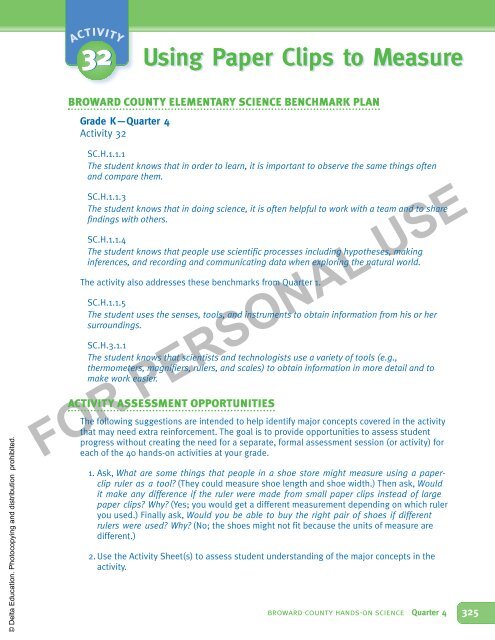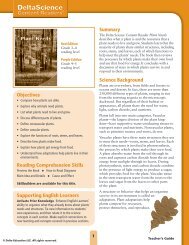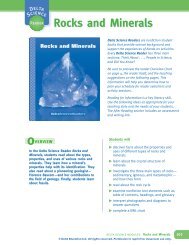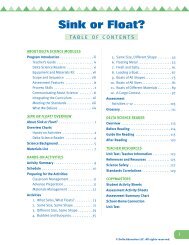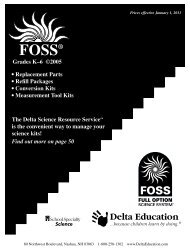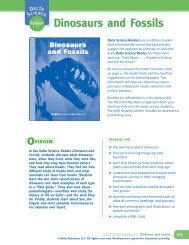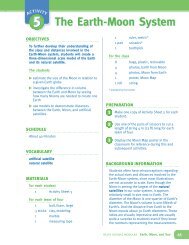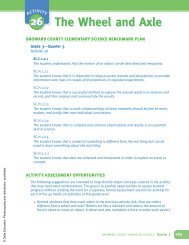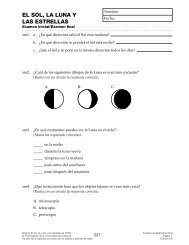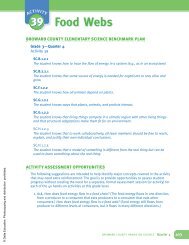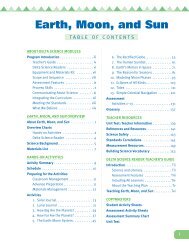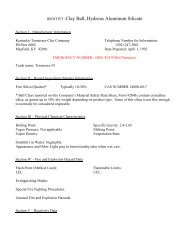32. Using Paper Clips to Measure - Delta Education
32. Using Paper Clips to Measure - Delta Education
32. Using Paper Clips to Measure - Delta Education
Create successful ePaper yourself
Turn your PDF publications into a flip-book with our unique Google optimized e-Paper software.
In addition <strong>to</strong> the above assessment suggestions, the questions in bold and tasks thatstudents perform throughout the activity provide opportunities <strong>to</strong> identify areas that mayrequire additional review before proceeding further with the activity.326FOR PERSONAL USEactivity 32 <strong>Using</strong> <strong>Paper</strong> <strong>Clips</strong> <strong>to</strong> <strong>Measure</strong>© <strong>Delta</strong> <strong>Education</strong>. Pho<strong>to</strong>copying and distribution prohibited.
Activity Sheet 32<strong>Using</strong> <strong>Paper</strong> <strong>Clips</strong> <strong>to</strong> <strong>Measure</strong>My paper strip is 6 paper clips long.How many?My paper strip is 1 paper clips wide.How many?What could you measure with a <strong>Paper</strong> Clip Ruler?Draw a picture.Student drawings will vary.y1Guiding the ActivityReview the word length (how far it is fromone end of an object <strong>to</strong> the other end), andremind students that in the last activity, theyused their feet <strong>to</strong> measure the length of arug. Ask, What problems might we havewhen using our feet as a unit of measure?FOR PERSONAL USEAsk, How could we measure the length ofan object so that we all get the sameanswer?As appropriate, read or review page 13 fromthe <strong>Delta</strong> Science Reader How do we learn?328 activity 32 <strong>Using</strong> <strong>Paper</strong> <strong>Clips</strong> <strong>to</strong> <strong>Measure</strong>Additional InformationStudents might suggest that their feet are<strong>to</strong>o big <strong>to</strong> measure the length of smallobjects and <strong>to</strong>o small <strong>to</strong> measure very longobjects. Also, people’s feet are different insize, so measurements are not always thesame for the same length.If we all measured using the same size item,we would all get the same answer. Studentsmay also suggest using a ruler, meter stick,measuring tape, or other standard measuring<strong>to</strong>ol. Accept all answers. If a ruler ismentioned, point out that it is made up ofunits of the same size by showing them oneas an example.© <strong>Delta</strong> <strong>Education</strong>. Pho<strong>to</strong>copying and distribution prohibited.
2Guiding the ActivityTell students that in this activity they willmeasure an object using units that are allthe same size. Give each student a strip ofconstruction paper and a cup containing 10paper clips. Hold up a strip of constructionpaper and show students the longer (30-cm,or 12-in.) dimension. Explain that they willuse the paper clips <strong>to</strong> measure the length ofthe strip of paper along the longer side.Additional Information© <strong>Delta</strong> <strong>Education</strong>. Pho<strong>to</strong>copying and distribution prohibited.34Demonstrate how <strong>to</strong> place the paper clipsend <strong>to</strong> end in a straight line. Tell students <strong>to</strong>be sure <strong>to</strong> follow a straight line along oneedge of the strip. As students measure,circulate <strong>to</strong> provide help as needed. Afterthey have lined up the paper clips, they cancount them.Distribute a copy of Activity Sheet 32 <strong>to</strong> eachstudent. Have students record the length ofthe construction paper strip on their activitysheets. They should write the number ofwhole paper clips they used <strong>to</strong> measure thelength from edge <strong>to</strong> edge. Point out that themeasurement contains two parts, a numberand some words. The number is the amoun<strong>to</strong>f paper clips. The words paper clips tell theunit used for the measurement.Record student results on the board. Call on afew students <strong>to</strong> report the length of the stripof paper in paper clips.Write the word width on the board. Tellstudents that width is the measurement ofthe shorter side of an object, or how widethe object is. Have everyone hold up theirconstruction paper strip and show you theshorter side, the width dimension.FOR PERSONAL USETell students <strong>to</strong> use their paper clips <strong>to</strong>measure the width of the strips. Havestudents record their measurements onthe activity sheets.Now they know that their strip of constructionpaper is 6 paper clips long and 1 paper clipwide.Remind students that the line of paper clipsshould go up <strong>to</strong> but not over the edge of thepaper. If they line up a paper clip that goespast the edge, they should remove thatpaper clip. They will measure in “whole”paper clip units.All student measurements should be 6 paperclips.All student measurements should be 1 paperclip.broward county hands-on science Quarter 4 329
5Guiding the ActivityEmphasize how helpful it was for everyone <strong>to</strong>use the same-sized unit of “1 paper clip.”<strong>Using</strong> the same-sized unit gave results thatstudents could all understand, unlike theresults with different-sized units, such asteacher feet and student feet. Point out thatusing the same-sized items <strong>to</strong> measureobjects also allows us <strong>to</strong> compare the lengthsof the objects. Ask, What if I measureanother strip of paper and find it is 4 paperclips long? Is that strip shorter or longerthan the strip of paper we measured?Emphasize that measuring helps us describeand compare objects.Show the class the chain of 10 large paperclips you assembled. Stretch the chain out ona strip of construction paper <strong>to</strong> measure thesame length students just measured, but donot count the clips. Invite the rest of the class<strong>to</strong> observe while a volunteer uses the chain<strong>to</strong> measure the paper strip again. The studentshould count how many full paper clips of thechain cover the length. Ask, Was it easier <strong>to</strong>use the chain of paper clips or <strong>to</strong> line upthe paper clips one by one?Ask, Are there any problems with using thechain of paper clips?Tell students that the chain of paper clips isa measuring <strong>to</strong>ol called a “<strong>Paper</strong> Clip Ruler.”Explain that a “ruler” is a collection of samesizedunits used for measuring length.FOR PERSONAL USEYou may wish <strong>to</strong> display the primary rulerand describe it as another kind of ruler. Tellstudents that in an upcoming activity theywill have an opportunity <strong>to</strong> measure with thiskind of ruler.Give students time <strong>to</strong> complete their activitysheets.330 activity 32 <strong>Using</strong> <strong>Paper</strong> <strong>Clips</strong> <strong>to</strong> <strong>Measure</strong>Additional InformationIt is shorter because 4 paper clips is shorterthan 6 paper clips.Students should say that it was easier andfaster <strong>to</strong> use the chain.Students may notice that the linked paperclips are a little shorter than the loose onesbecause they overlap at the links. Also, thechain can get tangled or become unlinked.© <strong>Delta</strong> <strong>Education</strong>. Pho<strong>to</strong>copying and distribution prohibited.
6Guiding the ActivityUse the linked chain of 20 small paper clips<strong>to</strong> measure the length and width of a strip ofconstruction paper.Ask, Why did we get a different measure ofthe length and width of the paper withthese paper clips?Additional InformationThe strip is 10 small paper clips long and2 small paper clips wide.The paper clips in the chain are all the samesize, but they are all smaller than the oneswe used.© <strong>Delta</strong> <strong>Education</strong>. Pho<strong>to</strong>copying and distribution prohibited.To reinforce the idea that units of the samekind can have variations, unhook a chain of10 small paper clips from the 20-clip chain.Hold up the two chains of 10 paper clips, oneof large clips and one of small, for students <strong>to</strong>compare. Have students count the paper clipsin each chain out loud. Ask what theyobserve.Elicit that even though the measuring chainsare made of the same kind of unit, the sizesare not the same. The term paper clip as aunit of measure can have different meaningsbecause paper clips come in different sizesand shapes.R EINFORCEMENTAllow all student teams <strong>to</strong> make and use achain of 10 large paper clips, a “<strong>Paper</strong> ClipRuler,” <strong>to</strong> measure the length of otherobjects they (or you) choose in the room.Have them report their findings <strong>to</strong> the class.Based on the measurements using samesizedunits, have them compare pairs ofobjects by size. Which is longer? Whichis shorter?Students may suggest that the same kind ofproblem occurred when measuring with theirfeet. Different people have different-sizedfeet. A measurement in paper clip units ortheir own feet units is not very useful whensharing information.FOR PERSONAL USEAssessment OpportunityThis Reinforcement also may be usedas an ongoing assessment of students’understanding of science concepts andskills.SCIENCE JOURNALSHave students place their completedactivity sheets in their science journals.C LEANUPCollect the loose paper clips, paper cups,construction paper strips, and primaryruler, and return them <strong>to</strong> the kit. S<strong>to</strong>re thetwo paper clip chains for use in Activity 34,or place them in the science center forfree-time exploration.broward county hands-on science Quarter 4 331
ConnectionsScience ChallengeChallenge students <strong>to</strong> make paper clip chainsfrom large or small paper clips for measuringaround their thumbs, wrists, and waists. Inaddition, the linked paper clips could be used<strong>to</strong> measure the circumference of an objectsuch as a playground ball, a pole, or a treetrunk. Students also might try using thechains <strong>to</strong> measure objects that are not sittingflat on the ground or some other surface,such as a picture on a bulletin board.Science and Language ArtsShare with students the book The Fattest,Tallest, Biggest Snowman Ever by BettinaLing (Cartwheel, 1997). This book showshow two children use nonstandard unitsof measure, including paper clips, <strong>to</strong>determine who has built the biggersnowman.Write the words big, bigger, and bigges<strong>to</strong>n the board. Review the suffix -er, whichwas introduced in the Science andLanguage Arts Connection in Activity 1.Then point out the suffix -est in the wordbiggest. Tell students that these letters areused for comparing more than two objects.Name some describing words and havestudents suggest the -er (comparative)and -est (superlative) versions. (small/smaller/smallest, cold/colder/coldest,wet/wetter/wettest, long/longer/longest)FOR PERSONAL USEAdd the science vocabulary introduced inthis activity <strong>to</strong> the class Word Wall.332 activity 32 <strong>Using</strong> <strong>Paper</strong> <strong>Clips</strong> <strong>to</strong> <strong>Measure</strong>Science and MathHave students measure four commonclassroom objects using their paper cliprulers. Then graph the data as a class. Havestudents draw in the number of paper clipsthat corresponds <strong>to</strong> the length of each object,or color in that number of squares above theobject’s picture. Ask students <strong>to</strong> comparethe lengths. Which object was longest andshortest? Were any objects the same length?Numberof<strong>Paper</strong><strong>Clips</strong>10987654321Length in <strong>Paper</strong> <strong>Clips</strong>Object© <strong>Delta</strong> <strong>Education</strong>. Pho<strong>to</strong>copying and distribution prohibited.


